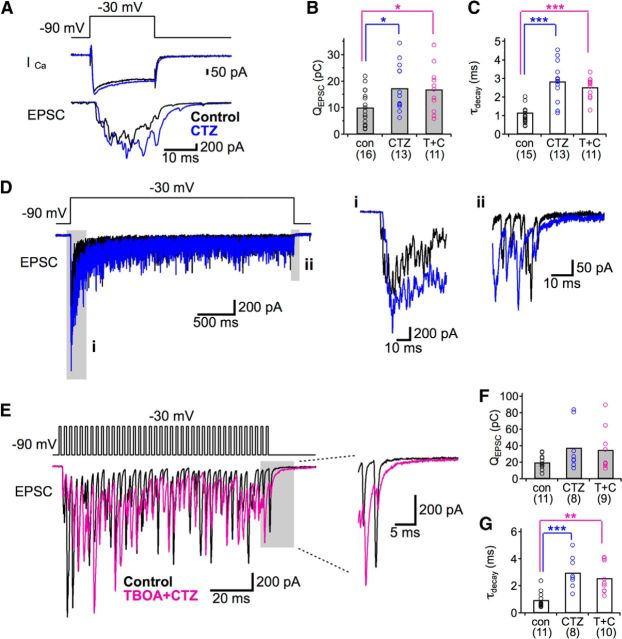Figure 3.
Effects of CTZ, a blocker of AMPA receptor desensitization, on hair cell synapses. Recordings of EPSCs were made from postsynaptic fibers while the presynaptic hair cell was depolarized from −90 mV to −30 mV in control conditions (black) and with CTZ alone (blue) or TBOA + CTZ (purple). A, Representative traces of Ca2+ currents (ICa) from presynaptic hair cells and EPSCs evoked by a single 20 ms presynaptic voltage step. B, C, Summary of EPSC charge (QEPSC; B) and the time course of EPSC decay (τdecay; C) in response to 20 ms presynaptic step. CTZ alone (blue) or TBOA with CTZ (T + C; purple) significantly increased QEPSC and τdecay. The effects of CTZ with TBOA were not significantly different from the effects of just CTZ on QEPSC or τdecay. D, Representative EPSCs evoked by a 3-s-long voltage step in control solution (black) and with CTZ (blue). The early portions of the EPSCs (i) were enhanced, and the decay times at response offset (ii) were prolonged in CTZ. E, Representative EPSCs evoked by a 100 ms train of 1 ms presynaptic voltage steps at 400 Hz in control conditions (black) and with TBOA + CTZ (purple). The decay times of the final EPSCs became slower in the presence of TBOA + CTZ (expanded inset). F, G, Summary of QEPSC (F) and τdecay (G) in response to 100 ms trains of 1 ms presynaptic voltage steps at 400 Hz. CTZ alone (blue) or TBOA plus CTZ (T + C; purple) significantly increased τdecay but did not significantly change QEPSC. The effects of CTZ + TBOA were not significantly different from the effects of CTZ alone in either case. *p < 0.05 (unpaired t test). **p < 0.01 (unpaired t test). ***p < 0.001 (unpaired t test). Number of pairs for each condition are indicated in parentheses.

